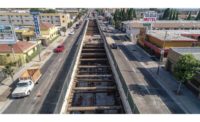He points to Santa Monica's Colorado Avenue. The light rail trains will run for one mile down the center of that busy artery to the project's final station, near Santa Monica Pier. Thorpe says to prep the site, workers first had to remove all existing utilities from under the tracks because once the trains begin to run "access will be impossible." He says that when workers began to dig and locate utilities, it became apparent that it would be no small effort. There were so many utility lines beneath the avenue that "it became virtually impossible to find a clear path to relocate all of them," Thorpe says.
The design-build contractor, Skanska-Rados Joint Venture, and lead designer Parsons Brinckerhoff stepped in to help.
"Early on in initial design, we potholed all existing utilities and used a BIM model to show existing conditions," says Brian Freund, Skanska-Rados project executive. The model showed an extensive, complex underground Southern California Edison system of power lines as well as numerous water, sewer and telephone lines. Crews had to get creative with staging materials while "cramming everything in the lane and a half of traffic on either side of the rail alignment," he adds.
One of the largest obstacles found beneath Colorado Avenue was a mile-long section of the 10-ft-dia Kenter Canyon storm sewer line, which the Army Corps of Engineers built in 1937. Still in use, the arched brick and concrete line required substantial testing of core and exterior materials to see if it could handle the loads of the light rail line.
Brett E. Jones, Phase 2 engineering manager with Parsons Brinckerhoff's Orange office, says the structure has withstood time and passed all the new tests as if it were "built yesterday." Jones says the storm drain will remain in place and rail tracks will go in above it.
When complete at the end of 2013, the 13-block-long Colorado Avenue utility relocation will have spanned about two years.
Neighborhood Watch
Besides the underground utility hurdles, the project has had to contend with numerous local stakeholders.
"The challenge of the job is that it travels through Culver City, West L.A. and Santa Monica, and each community has its own diverse set of stakeholders and stakeholder concerns," says Mike Aparicio, executive vice president for Skanska USA Civil, Los Angeles.
"There is not a week that goes by that there is not some sort of community meeting, whether for noise and dust, school access, design review, etc.," he adds.






